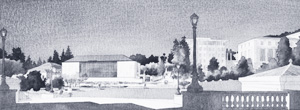LRDP process starts with public input
The challenge: to design a long-range plan for campus growth that balances interests, enhances the urban environment, and advances sustainable design
![]()
| 03 September 2003
| |
 The Chang-Lin Tien Center for East Asian Studies would be the first project built under the 2020 Long Range Development Plan. Its design would utilize architectural forms and materials similar to those incorporated in neighboring classical buildings, such as Doe Library. Image courtesy Capital Projects |
If you could help shape the look, feel, and academic strength of UC Berkeley for the next 15 years, how would you do it?
That, essentially, is the question before campus leaders as they begin to design a Long Range Development Plan (LRDP) that will guide the growth and development of the campus from 2005 through the year 2020. The current LRDP runs through 2005.
The campus community and public are invited to view initial concepts for the new plan as well as comment on the scope of issues to be addressed in the environmental impact report on the plan. A public meeting will take place Sept. 22 at the Krutch Theater on the Clark Kerr Campus. Individuals may stop by at any time between 5 and 9 p.m.
“We intend to consult extensively with the campus community during the fall 2003 semester as we develop the 2020 LRDP,” says Kerry O’Banion of Capital Projects, who along with CP’s Jennifer Lawrence is managing the LRDP project. “To some extent this will be done through established campus committees, although we are also developing a broader outreach strategy.”
Designing a plan that will meet current needs, anticipate the campus’s needs 15 years from now, and balance competing interests (such as student housing versus parking) is an extremely challenging task. Fortunately, the foundation for the 2020 plan has already been established in two key campus documents:
The Strategic Academic Plan (SAP) outlines the key challenges the campus faces in sustaining academic excellence, and recommends principles and initiatives to address those challenges. The New Century Plan builds upon the SAP, with design policies and guidelines to shape the campus’s future physical development.
Committees of faculty, students, and professional staff worked on the two documents, which were subjected to extensive campus and community review at more than 20 campus and public forums. Together, O’Banion says, the Strategic Academic Plan and the New Century Plan describe a long-term vision for UC Berkeley: the role of the new 2020 LRDP is to describe what the campus plans to do in the next 15 years to realize that vision, including:
• Renewing the aging campus with new state-of-the-art facilities, where both undergraduate and graduate students learn through active participation in public-interest research;
• Concentrating academic programs on and around the core campus, to maximize social and intellectual interaction;
• Providing more students with good, reasonably priced housing within walking distance or a 20-minute transit ride;
• Adopting design standards that preserve and enhance Berkeley’s historic legacy of campus landscape and architecture;
• Setting limits on enrollment. The UC system has directed the campus to accept 4,000 additional students between 1998 and 2010. Once this occurs, the LRDP will recommend that our enrollment should stabilize in order to maintain academic excellence and a strong intellectual community.
Growth mostly on and around central campus
To meet these goals, the 2020 LRDP will consider various options for campus growth, including up to an 18-percent increase in academic and support space, up to a 30-percent increase in campus housing, and up to a 30-percent increase in parking. The vast majority of the growth in academic space — more than 90 percent — would occur on and around the central campus.
“The 2020 LRDP will deal not only with the scale and character of future campus growth, but will also describe how this new growth will be distributed on and around campus,” said O’Banion. “It will also describe the measures the campus will take to ensure that each new project preserves the park-like environment of the central campus, enhances the vitality of the city around us, and advances the art of sustainable design.”
UC Berkeley will conduct a comprehensive environmental impact report (EIR) on the new LRDP, as required by the California Environmental Quality Act (CEQA). The new LRDP and its EIR are being prepared simultaneously, so that the findings of the EIR analysis can help shape the LRDP itself.
The EIR also will assess the impacts of the Chang-Lin Tien Center for East Asian Studies, the first project to be built under the 2020 LRDP. The center would be located on campus, across the central glade from the main library.
The official public comment period on the scope of the environmental analysis for the 2020 LRDP opened on Aug. 29 and will close Sept. 29. Following the close of the public comment period, Capital Projects staff will create a draft 2020 LRDP and EIR, a single document that will be available for public review in Spring 2004. The final LRDP and its EIR are scheduled to go to the UC Board of Regents in fall or winter of 2004.
Comments about the scope of the new LRDP and EIR may be made at the Sept. 22 public meeting or sent to: Jennifer Lawrence, Capital Projects, 1936 University Ave., Suite 300, Berkeley, CA 94720-1382. Email comments may be sent to 2020LRDP@cp.berkeley.edu.

